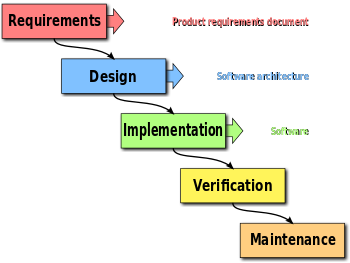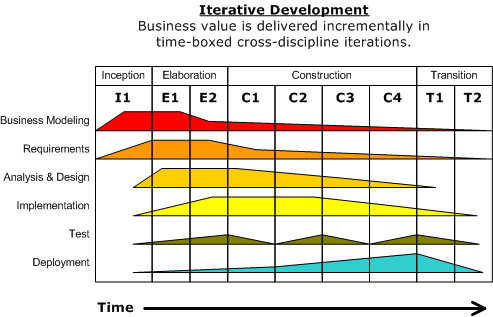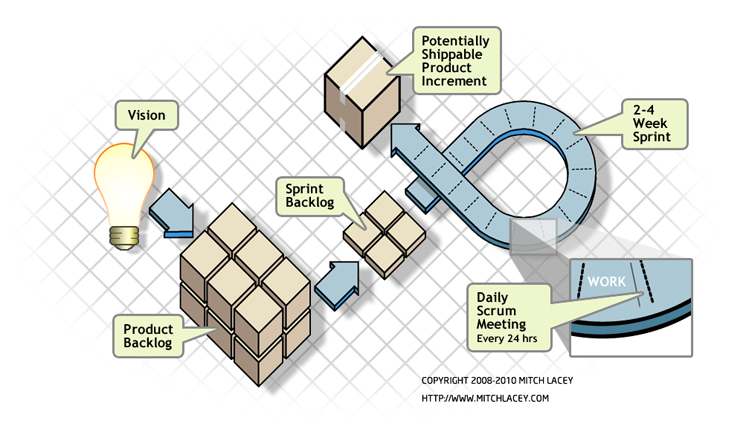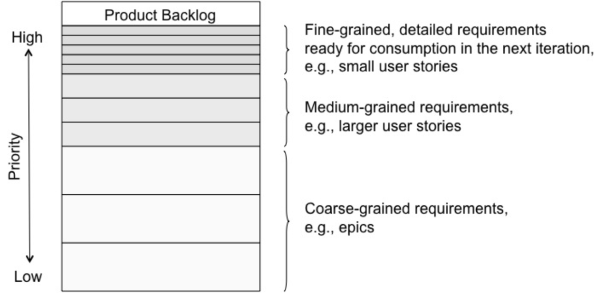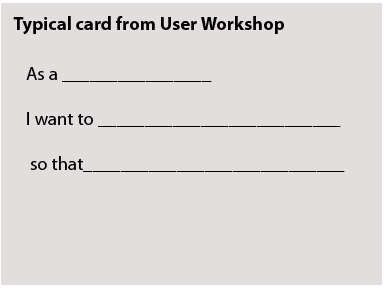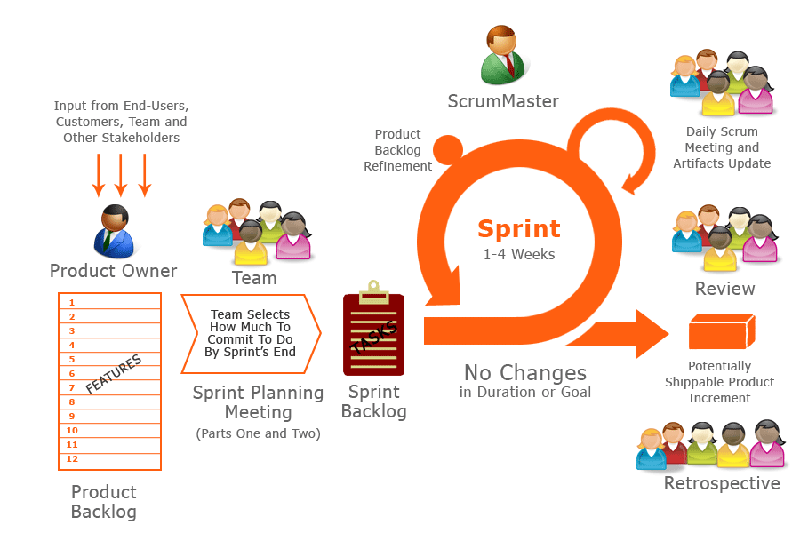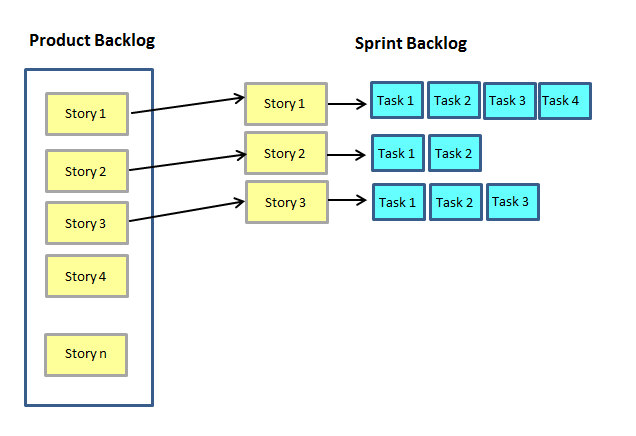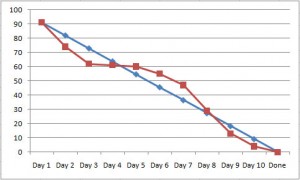Agile Project Management with SCRUM - US
Agile Project Management with SCRUM - US
Project Methodology History
- Thinking back over the history of software
- What is different about software
- more malleable during development compared to items in the physical world
- Fewer set rules on how things work (Ctrl-Atl-Del, Ctrl-x, Ctrl-c, Ctrl-v)
- Closer to thought processes than to physical processes
- Different limitations (gravity matters, programs should not be slow)
- Different type of documentation
- What is different about software
- Examples from years ago
- Waterfall for developing operating systems
- For a substantial time hold meetings with users group (Banks, large installations)
- Decide on changes to be made in next version
- Develop the requirements
- Design all needed changes for a substantial time period
- Approve the design document causing it to be (somewhat) unchangeable
- Develop the new features
- maybe 600 developers working over a substantial time period
- Test the system
- In some cases find out that there are problems with the system as designed
- Release the new version to beta testers
- Beta test users may find bugs that must be corrected
- Release the software to all users
- Go back and correct any bugs that are found
- For a substantial time hold meetings with users group (Banks, large installations)
- Software Consulting
- Price is given to customer perhaps through a bidding process
- Customer and consulting requirements team draw up the requirements
- Requirements are signed off by customer (with a signature on a document)
- This defines what is to be built
- Design team creates a design document
- Customer reads (or not) the design document
- Customer approves design document with a signature on a document
- Development teams develops the software
- Testing team tests the software
- Product is released to customer
- These are called Waterfall methodologies
- Waterfall for developing operating systems
- Originally project management in software
- Reflected manufacturing or construction project management
- New physical products or buildings are envisioned
- Requirements are gathered
- Products are designed (by draftsmen, engineers, scientists)
- Models may be built
- various parts may be machined or assembled to try them out
- Product testing takes place if in manufacturing (usually this would be final testing)
- Products put into production (might be on some type of assembly line)
- This give rise to the waterfall concept in project management
- Reflected manufacturing or construction project management
Waterfall Project Management
- The Waterfall project management methodology
- Problems with the Waterfall for software
- Software is not a manufacturing or building construction process
- In particular there is no manufacturing or assembly line
- It is more like everything up to final testing
- Software development allows for a more malleable process
- You cannot add a new story to a building
- You cannot easily make a bridge 200 feet longer
- You cannot easily add a extra wheel to a car
- You can add a new feature to software
- If the change is seen soon
- Complexity of software
- Design may not be understood until software is partially built
- Partially built software may cause the requirements to change
- The user did not really understand what a requirement might entail
- The user finds that a new requirement is needed
- There will be 12000 items in a list and not 20
- Team structure and collaboration
- Does design need a special team that is separate form development
- Development takes the software architect's designs, looks at them
- Places them in the round basket on the floor next to their desk
- Merrily goes on developing what they think is needed
- Development takes the software architect's designs, looks at them
- Does design need a special team that is separate form development
- Software is not a manufacturing or building construction process
- References
Unified Process
Recognizing problems with the Waterfall method the Unified Process is an alternative
- Unified Process is Iterative and Incremental - Time boxed iterations that incrementally build the product
- It became important partially because of Rational Rose (UML) and IBM's Rational Unified Process
- Consists of a set of phases Inception, Elaboration, Construction, and Transition
- Inception
- Establish justification
- Project Scope
- Use cases
- outline architecture
- Find risks
- Preliminary project schedule
- Elaboration
- Capture a large portion of system requirements
- Address risks
- Create UML use case, class, and package diagrams
- Deliver a plan for the construction phase
- Construction
- build the system using a set of time boxed iterations
- Use UML diagrams in defining the system
- sequence, activity, collaboration, state, and interaction
- Transition
- Deploy to users
- Get feedback
- User training
- Inception
- Unified process
- similar in some ways to waterfall
- Designs are made mostly up front in the process
- Users see the product at the end during transition
- The phases are similar to a Waterfall Process (but slightly different)
- Differences from Waterfall
- The disciplines overlap unlike Waterfall i.e. business modeling and implementation
- UML is used extensively for designing and documentation
- Documentation consists of several types of UML diagrams
- In particular the sequence, state, activity, class, and package diagrams
- Documentation consists of several types of UML diagrams
- similar in some ways to waterfall
- References
Agile and SCRUM
Agile was proposed as an alternative to the Waterfall method. It employs some of the concepts used in the Unified Method.
Agile - These are software development methods in which the software solutions are arrived at through collaborative cross-functional, self-organizing teams. It features iterative development, early delivery, rapid response to changing requirements, and continuous improvement of processes.
Scrum - Refers to a particular Agile methodology as shown in the image below. It places a number of named concepts within the Agile methodology. The word scrum refers to scrum in Rugby where the team attempts to move the ball forward through a rugged collaborative effort (bruises and all).
Agile SCRUM can be said to have a number of organizing principles. These have developed over a number of years through experimentation with the processes of Agile. This list comes from the book Essential Scrum by Kenneth Rubin.
- Prediction and Adaptation - Waterfall is a predictive methodology (predict up front). Scrum is an Adaptive methodology (adapt to changing requirements)
- Validated Learning - validate important assumptions fast, learn through many learning loops
- Work in Progress (WIP) - implement small sized slices of the project so that a large amount of work in progress is not disrupted by changes in requirements or designs. Focus on idle work and not idle workers.
- Progress - measure progress by what has been delivered and validated not by how far we are along a predefined plan
- Performance
- build in quality by moving forward but not hurrying.
- If quality is built in then there will be less costly rework required.
- Value is built in to a high level of confidence validated by testing.
- Have the minimal sufficient amount of ceremony, amount of documentation, and amount of sign off ceremony
- The purpose of documentation
- Part of the product, user manual, user guide, etc.
- Capture important discussions, decisions, or agreements
- Help new team members come on board
- Regulatory requirements
- The purpose of documentation
- In Class Exercise
- Discuss project management methodologies that you are aware of. Where do they fit in terms of their characteristics of Prediction vs Adaptation, Validated Learning, WIP, Measurement of Progress, and Performance of the team.
- Discuss any projects that you have worked on that you are willing to share and any problems and solutions that were encountered.
- Note that Projects to be discussed can be either software, hardware, construction, or mechanical
- References
- Wikipedia on Scrum Software Development)
- Wikipedia on Agile Software Development
- Essential Scrum by Kenneth Rubin, Addison Wesley, January, 2015
Sample Project for use in the class
There is a company that wants to have an internal website to keep their employees and representatives apprised of the company news. They also want to encourage networking among employees so there will be sharing and forums on the website where employees can gather into networks, share information, and make friends.
Build a web based system that will:
- Have the company news on a main page
- Allow editors to create and approve news
- Have the CEO statement on a page
- Allow the CEO to have a weekly statement
- checked by someone as an editor
- Allow users to comment on the CEOs statement
- Users can get other users as friends
- Must have a search methods to find friends
- Users can put in their profile
- Name
- Profession
- Personal Statement
- Image
- Other??
- Users can contribute to various forums
- have an approval process for the forums
- Forums have a structure that is easy to use so people can join the forums they would enjoy
- Users and editors can add articles to the company news
- have an approval process for the news
- Put in a bad word recognizer so that inappropriate articles or forum entries are stopped
- The website should not be overly dependent upon commercial off the shelf (COTS) products
- So it will unique to the company
- Anything else that would encourage the company to be a good place to work
Agile Scrum Core Concepts
The concepts here are taken from experience, web site discussions, and books see the references for more details on website and book references.
- Product Backlog - a set of user stories
- At the start there are Epic Stories that suggest the software to be developed
- Sprints - Scrum uses short duration iterations to complete work
- Sprint Backlog - Developer chosen Short Stories that are decomposed from Epics that can be finished in a sprint
- Daily Scrum meeting - a short collaborative meeting of the team to plan the day's work
- Users and stakeholders
- Product Owner
- Scrum Master
- Development Team
Scrum Roles
- Scrum does not follow the roles below that have been common during the last decades
- Managers
- business analysts for gathering requirements
- Software architecture team
- Development team
- Testing team
- Database administrators
- Network and System Administrators
- These roles originated in the Waterfall method
- It is usually the hiring pattern for companies
- It usually indicates the personnel hierarchy and salary levels in a company
- Scrum has the roles given below
Users and Stakeholders
- Users are those who will eventually use the products
- Stakeholders are those internally who have a vested interest in the product
- Stakeholders might also be representatives of those with a vested interest
Product Owner
- the empowered central point of authority over the product's development
- The person or team that interacts with the users and stakeholders and is their voice
- Similar to a Product Manager
- The person or team that communicates to the development team what to build
- Ensures that the acceptance criteria are specified
- Their might be business analysts working on the acceptance criteria
- The product owner ensures that those acceptance criteria are used in testing the product
- Responsibilities of the Product Owner
- Economics - Make sure that good economic decisions are made
- For any releases
- For each Sprint
- For the Product Backlog
- Planning participation
- For the Product (i.e. the User Stories and Product Backlog)
- For Sprint planning (Which Stories are to be in the Sprint Backlog)
- For Releases (is the release ready what is the release date)
- For the company portfolio (how does this product fit in the company portfolio)
- Groom the Product Backlog
- Removing and adding items to the Product Backlog
- Define acceptance criteria and verify they are met
- Collaborate with all people involved
- Collaboration being the keyword
- It is easy to misuse the Sprint Backlog to force more work from the development team
- Economics - Make sure that good economic decisions are made
- Characteristics of the Product Owner
- Domain Skills
- People Skills
- Collaborative
- Communicator
- motivator
- Negotiator
- Builds consensus
- Decision maker
- Accountable
- In Class Exercise
Assume that the Product Owner is in the management hierarchy of the company, say at a fairly high level. Those in the hierarchy above that position set the dates for releases, the budget for the project, and the number of developers that can be hired. What can be the effects on the project and the Agile method? How can any problems be mitigated?
Scrum Master
- Gets everyone to understand and embrace the Scrum values, and principles
- Provides process leadership
- Helps the organization develop their own Scrum approach
- Coaches the Product Owner and the Development Team on process
- Responsibilities
- Develop a solid relationship with and trust of the Product Owner
- The Product Owner is often a high level manager with authority
- Understand the Scrum process well
- Remove impediments that inhibit the team
- May need to use the authority of the high level manager
- Coach the Product Owner and Development Team
- Protect the development team
- Change agent
- Needs to be able to change minds
- Develop a solid relationship with and trust of the Product Owner
- Characteristics
- Knowledgeable
- Calm and patient
- Collaborative
- Transparent
- No hidden agendas
- Upfront and straight forward
- Communicative
- In Class Exercise
- Discuss problems that you can see with this position and solutions for those problems
- What can happen when the Scrum Master is managed by the Product Owner?
Development Team
- Plans each Sprint
- Performs Sprint execution until "Done"
- Helps Product Owner groom the Product Backlog
- Holds daily Scrum
- Helps in adapting the Scrum process
- Team characteristics
- Cross functional
- Members will have different skills
- Software architecture
- Testing
- Development
- Database
- UI design
- Network and system admin
- Members will have different skills
- Diverse
- Senior and Junior members
- many viewpoints
- Accepting of others
- Collaborative and self organizing
- Sufficient for completing the entire set of Sprint tasks
- Each member performs a broad set of tasks and also has a specialty
- Software architecture might be a specialty
- Testing, coding, and database work might be other assigned tasks
- Teams members move between task types
- Long Lived
- The team is such that members want to continue on the team
- The organizational structure is devoted to keeping teams together
- Loss of team members is a loss of domain and process knowledge
- Cross functional
- In Class Exercise
- Discuss the issues (for and against) the separation of Software Architecture, Testing, and Development teams
- Discuss the issues related to members of the team in terms of collaboration ability, self organization, testing, database administration, and system/network administration. How would any issues be mitigated?
Managers
- Managers have concerns with implementing Agile
- 30% of respondents listed Loss of Management Control as an issue
- 30% of respondents listed Management Opposition as an issue
- VersionOne 8th Annual State of Agile Report
- Does Agile effect the manager role? Yes and no
- Functional Managers responsibilities in Agile
- Team formation, including setting goals, empowerment, and appointing team members
- Addressing team issues, such as badly behaving team members
- Nurturing, energizing
- Developing competence
- Functional leadership
- Coaching
- Team integrity
- Scrum for small to medium projects does not use a Project Manager
- The duties are spread between the Product Owner and the ScrumMaster
- One thing to remember is that the Project Manager role varies company to company
- In Class Exercise
- Discuss the role of the Project and Functional Managers in both an Agile and non-Agile environment
- What are the similarities and the differences?
- Explain the role of the Project Manager as you know it
Product Backlog
The product backlog is a prioritized listing of the user stories that make up the product requirements
- User Stories at the highest priority are of finer granularity
- Image from heliosobject.com
Requirements and User Stories
- In Waterfall requirements are detailed up front and stand alone
- In Scrum requirements are negotiated through conversations
- Conversations happen throughout development
- In Scrum requirements are often created as a set of User Stories
- User Stories start out as Epics
- Epics are very high level descriptions of the product
- Epics are broken down before they are included in Sprints
- Epics usually would take longer than a Sprint's time interval
- Epics become on decomposition Themes, and then User Stories
- Themes represent a partial breakdown of the Epics that is not at the level of a Story
- Stories are of small duration that can be included in a Sprint, two to four weeks of effort
User Workshop
- Often the Epics, Themes, or User Stories are written on 3 by 5 cards or on Post-it-notes
- Sometimes this is done in a User Workshop
- Epics that are of the highest priority are broken down into Themes.
- Themes are broken down into User Stories that can be implemented in a Sprint
For each card there is a:
- Conversation among the development team, stakeholders, and product owners
- During the user workshop to bring clarity to the item
- During grooming of the Product Backlog
- Break Epics into Themes and Themes into User Stories
- During sprint planning
- During development
- Set of conditions of satisfaction created
- Allows Product Owner and Developers to say story is "Done"
- Can be placed on back of card during user workshop
Characteristics of User Stories
- independent - they do not depend on each other
- negotiable - they are place holders for later conversations
- value - the stories are valuable to the users or customers
- Can be Estimated - the story can be estimated by the development team
- Sized to Sprints - can be implemented and "Done" during a Sprint
- Testing - the story has satisfaction criteria that can be tested
Backlog Grooming
- Grooming consists of
- User stories are updated as the Sprints occur
- New stories can be created as Sprints occur
- Epics are broken down into Themes and User Stories
- Stories priority can be updated
- Grooming is done by
- the Product Owner
- With input by
- Stakeholders
- Developers
- ScrumMaster
- In Class Exercise
- Assume that we are in a user workshop. Take the sample project given in the table of contents and create a Product Backlog using its description. This will be done as a group effort. Appoint individuals to act as the Product Owner, Stakeholders, ScrumMaster, and Developers
- First create a set of Epic Stories
- Prioritize the stories
- Create a set of Themes from the first two highest priority Epics
- Create a set of User Stories from several of the Themes
- Discuss any problems encountered during this effort and propose solutions
- Discuss the times that you have seen user specify requirements upfront only to later say
- "This is not correct"
- "I didn't really mean what I said"
- "Read my mind and not my words"
- "It is not what is needed"
Estimation and Velocity
- The question - How long with product development take?
- Requires estimation of size of the Epics, Themes, and Stories
- Requires knowing how much is done per Sprint
- Velocity tells the story points or effort hours accomplished in a Sprint
- Just a matter of record keeping
- Velocity tells the story points or effort hours accomplished in a Sprint
- Requires the length of each Sprint, i.e. two weeks
Estimate Size of the development effort
- By T-shirt sizes (small, medium, large, extra-large)
- By Story Points
- Some arbitrary scale is used
- Fibonacci numbers 1, 2, 3, 5, 8, 13
- Recognition that the larger the effort the harder it is to assign a size
- Series of numbers 1 to 10 for example
- Standard method of rating something
- Fibonacci numbers 1, 2, 3, 5, 8, 13
- Some arbitrary scale is used
- By ideal hours sometimes called effort hours
- This is the method used most often in the past
- That is estimate number of person hours project will take
- Account for time off
- Account for meetings
- Account for Scrum related activities, i.e. grooming the Product Backlog
- An ideal hour is not the same as actual time spent
- This is the method used most often in the past
- T-shirt sizes is very rough but could be applied to a portfolio of products
- Product A is extra large, Product B is small so lets work on Product B
- Story points are good for Epics, Themes, and User Stories
- Effort hours are usually used for the tasks of a User Story
Planning Poker for Estimating
- First choose a scale to represent size, for example a Fibonacci sequence
- The full Scrum team plays the "game" while estimating
- Product Owner presents, describes, and clarifies Product Backlog Items
- ScrumMaster coaches the team to help it apply planning poker
- Development team generates the estimates
- Each team member has a set of planning poker cards
- For an item chosen by the Product Owner
- Development team discusses the item and ask questions
- Each team member selects a card representing their size estimate
- All estimate cards are exposed at once
- If all cards are the same that size is assigned to the item
- If the cards are not the same the team discusses the issues and re-votes until consensus
- In Class Exercise
Come up with at least two User Stories that pertain to development efforts that you are aware of
- Decide whether they are Epics, Themes, or Stories
- Decompose if they are Epics or Themes into Stories
- Play planning poker to determine the size of the stories.
- Use the Fibonacci playing cards given in the zip file at the bottom of this document
- They might also be handed out in class
- Use the Fibonacci playing cards given in the zip file at the bottom of this document
Velocity
- Velocity gives the size of the effort accomplished per Sprint
- Prior history is the best way to determine velocity
- Otherwise velocity is an educated guess
- What most development teams do is guess at least at the start of Product Development
- Often ranges are used early in the development process rather than single figure estimates
Questions to be asked
- Does the organization have a record keeping method that can give velocity?
- Timekeeping system buckets in which developers put their hours?
- Hours kept track of by some other system?
- The advantages of Sprints for determining Velocity
- User Stories are assigned to Sprints
- Completed Stories are kept track of
- Each story had a up front estimate
- Therefore Velocity during the Sprint can be calculated
Hard Problems In Development:
- Getting accurate recording of development time. Sprints automatically give these.
- Accounting for all of the other time: meetings, planing, breaks, education, mentoring
- Applying these times in estimating future development efforts. Planning poker is intended to help solve this problem by using multiple opinions from developers and consensus among the developers.
Misusing Velocity
- Velocity is a planning tool
- It is not intended to be a performance metric
- Which team has the highest velocity is not a good metric.
- Telling a team that their velocity is not high enough is not appropriate.
- Misuse of Velocity may cause the teams to inflate their numbers
- Misuse of Velocity may cause the teams to write poorly structured code
Sprints
- Image from http://www.jaftalks.com
Sprint Planning
- Sprint planning occurs before each Sprint
- Participants are:
- Product Owner
- Gives a goal for the Sprint
- Listens and gives input
- Does not determine what is to be delivered
- ScrumMaster
- Observes, facilitates, and asks questions
- Development team
- Determines what it can deliver
- Makes a commitment to deliver
- ScrumMaster can challenge the items to be delivered
- Product Owner
Development team activities
- Determine capacity
- Capacity indicates the amount of work the team can do in the Sprint
- Story Point methodology - dependent upon prior team story point velocity
- Effort Hour methodology - dependent upon prior team effort hour velocity
- Capacity indicates the amount of work the team can do in the Sprint
- Use a method such as Poker Planning to choose Product Backlog Items
- Backlog items chosen until capacity is filled
- Decompose Product Backlog Items into development/programming tasks
- Estimate the tasks in Effort hours
- Check that effort hours also match the capacity
- In Class Exercise
Use the Product Backlog developed in prior activities to choose items for the Sprint Backlog
- Chose how long a Sprint will be
- Come up with a figure for available effort hours for each developer
- Usually these figures would come from prior effort hour velocity
- This gives the capacity for the Sprint in effort hours
- Chose Backlog Stories by priority
- Use the Story point estimates assigned to the story during grooming to fill capacity
- Decompose Backlog items into development tasks
- User planning poker with effort hours to determine task effort hours
- Other methods can be used
Sprint Execution
- During Execution development team self-organizes
- ScrumMaster participates as coach, facilitator, and impediment remover
- Product Owner clarifies questions
- Development team
- Manages flow of work
- What work can run in parallel
- What are dependencies between tasks
- Who should do which tasks
- Are there skills constraints
- Manages flow of work
- Daily Scrum
- 15 minute timeboxed activity
- Are there issues blocking implementation
- Discussion of possible dependencies
- How to organize the work
- 15 minute timeboxed activity
- Team uses best practices
- Automated testing
- Automated builds
- Code reuse
- Coding standards
- Common coding environment
Sprint Burndown and Burnup Charts
- Image from timberwolfconsulting.com
Burndown Charts
- give the amount of effort remaining in the Sprint
- either effort hours or story points per day
- The chart shows if the Sprint is on track to finish correctly
Burnup Charts
- These are the opposite
- Shows the amount of effort expended in the Sprint
Sprint Review
- Focuses on the product
- In a meeting the product is inspected and reviewed
- Participants are:
- Product owner
- ScrumMaster
- Development team
- Stakeholders
- Development team demonstrates the results of the Sprint
- Discuss and adapt to changes needed
Sprint Retrospective
- Sprint Retrospective focuses on the process
- Product Owner, ScrumMaster, and Development team participate
- Activities in Retrospective
- Set an appropriate atmosphere
- Identify insights
- Determine actions to adapt the process
- References
Technical Dept
- The amount of time needed to correct faults/problems in a software system.
- Causes of technical dept
- Development was hurried so code is poorly structured
- APIs to other systems change over time
- Design makes no sense over time
- Code duplication instead of reuse
- Insufficient testing
- Defects in the software
- Inexperienced team members
- Insufficient time, budget or human resources causing shortcuts to be taken
- Most system gradually degrade in functionality as new features are added
- Most organizations do not account for time needed to address technical dept
- Code rewrites
- Design changes
- Spaghetti code
- Developers using the shotgun approach to development (doesn't work try shooting it again)
- Object Oriented Code with too many classes and too much inheritance
Issues and Impediments with Agile
Concerns with implementing an Agile Initiative From VersionOne 8th Annual State of Agile Report
- Lack of up-front planning 30%
- Loss of management control 30%
- Management opposition 28%
- Lack of documentation 24%
- Lack of predictability 23%
- Lack of engineering discipline 20%
- Dev team opposed to change 17%
- No concerns 19%
- Inability to scale 18%
- Regulatory compliance 15%
- Quality of engineering talent 13%
- Reduced software quality 9%
- References
Top 10 issues with Agile VersionOne 8th Annual State of Agile Report
References
- Essential Scrum by Kenneth Rubin - this is a very good resource that paints a fairly complete picture of the Agile Scrum methodology. It can be found on Amazon.com
- International Scrum Institute
- AgileMethodology.org
- Wikipedia on Agile
- Wikipedia on Scrum
- AgileAlliance.org
Agile in Mechanical Engineering and Product Design
- Lean and Agile Mechanical
- Agile in Medical Device Development
- Agile and Mechanical Engineers
- Scrum in Mechanical Product Development
- Challenges of Becoming Agile
- Improve competitiveness with Agile
- Improved Product Development with Agile

